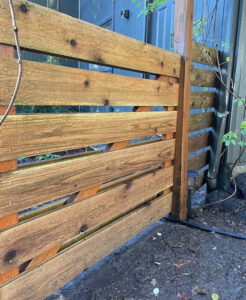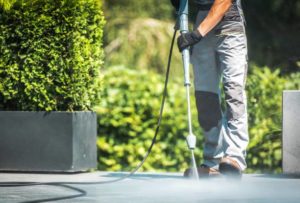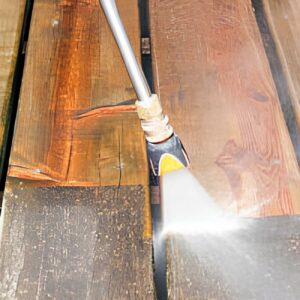Keeping your home clean can be hard. A pressure washing checklist helps. This list will guide you through each step for a clean house. Let’s get started!
Key Takeaways
- Clear the area of obstacles and protect sensitive surfaces before pressure washing to avoid damage.
- Choose the right pressure washer for your needs, considering size, power, and nozzle options.
- Check equipment levels and parts for any issues to ensure a smooth cleaning process.
- Master different washing techniques for various surfaces to achieve cleaner results without causing harm.
- After washing, inspect for missed spots and store equipment properly to maintain its condition.
Pre-Pressure Washing Preparations
Before starting the pressure washing, make sure the area is clear of obstacles and sensitive surfaces are protected. Close all windows and cover vents to avoid any water damage inside.
Clear the Area of Obstacles
Move all decorations and items 15 feet away from where you plan to pressure wash. This includes taking external decorations off walls and moving small garden furniture out of the way.
For decks or patios, clear everything that can be moved easily. If something is too heavy, try to cover it instead.
Vehicles should not be in the driveway or garage during pressure washing. Park them further away to protect them from water and debris. This step ensures nothing gets damaged by high-pressure water spray.
A clean space leads to a cleaner wash.
Protecting sensitive areas comes next after clearing obstacles.
Protect Sensitive Areas and Surfaces
After moving things out of the way, it’s key to guard delicate parts around your home. Make sure all windows and doors are shut tight. This step is simple but very important for keeping water outside where it belongs.
Next, grab some plastic wrap to cover cameras and tape for electrical outlets and light fixtures. This keeps them dry and safe while you use the pressure washer.
I once forgot to tape an outdoor electrical socket before starting. Midway through, water got into the socket, causing a short circuit that knocked out power in part of my house. It was a hard lesson on why protecting sensitive areas matters so much.
Always double-check that everything is covered or closed off before turning on your pressure washer.
Close All Windows and Cover Vents
Make sure all windows, storm windows, and doors are shut tight. This stops water from getting inside your house during pressure-washing. It’s also smart to cover vents to keep water out.
Covering painted doors protects them from damage.
On service day, avoid having deliveries or other workers around. This makes it easier to clean without interruptions. Keeping these areas secure ensures a smooth pressure-washing process for your home’s exterior.
Choosing the Right Pressure Washer
When selecting a pressure washer, consider the size and power needed for your tasks. Different nozzle options also play a crucial role in achieving optimal cleaning.
Consider the Size and Power Needs
When selecting a pressure washer, take into account the specific size and power requirements. It’s crucial to recognize that different surfaces necessitate varying levels of pressure to prevent any potential damage.
For instance, typical household chores such as deck cleaning typically require approximately 1,500-2,000 pounds per square inch (PSI), while high-pressure cleaning may involve 3,000 PSI or more.
Remember, higher gallons per minute (GPM) rates result in faster work but also utilize more water. For instance, cleaning concrete generally requires a higher GPM compared to wood siding.
When applying bleach or other cleaning chemicals with your pressure washer, it’s recommended to adhere to the manufacturer’s guidelines regarding dilution ratios.
This understanding of the appropriate size and power requirements ensures a safe and effective pressure washing experience, preventing any potential damage.
Understand Different Nozzle Options
Different nozzle options offer versatility for pressure washing. Nozzles are labeled by the angle of the spray they produce, typically ranging from 0 to 65 degrees. Nozzles with lower degrees produce a more focused and powerful spray, ideal for tough stains and high-pressure cleaning.
Conversely, higher degree nozzles create wider sprays, suitable for larger surface areas such as decks or driveways. Moreover, nozzles with soap dispensing abilities can be used to apply detergent before using higher pressure nozzles.
Understanding these differences is crucial when choosing a nozzle option based on the cleaning task at hand. For example, using a narrow-angle nozzle on soft surfaces like wood can result in damage due to excessive force concentrated in one area.
Conversely, using a wide-angle nozzle may not effectively remove stubborn grime from concrete or metal surfaces.
Preparing Your Equipment
Before starting pressure washing, ensure your equipment is ready. Inspect all levels and parts for any issues. Check everything thoroughly to avoid problems during cleaning.
Inspect Water, Fuel, and Oil Levels
Before starting the pressure washing process, it’s essential to inspect the water, fuel, and oil levels in your equipment. Ensure that the water pump has enough water and check outside water spigots to ensure proper flow.
For fuel-powered machines, confirm that there is sufficient fuel in the tank to complete the task. Also, ensure that there is enough oil for smooth engine operation.
By conducting these checks in advance, you can avoid interruptions during your cleaning session and ensure that your pressure washer operates effectively throughout the entire process.
Moreover, specific measurements should be considered when mixing SH solutions for different surfaces. For example, aluminum siding may need a mixture of 0.5-2% SH for optimal cleaning results.
Understanding these ratios will help achieve superior exterior cleaning outcomes while protecting delicate surfaces from damage.
Check High-Pressure Hose and Nozzle
Inspect the high-pressure hose and nozzle for leaks. Test stained wood surfaces. Check the hose and nozzle for any damage or wear, especially where it connects to the pressure washer and spray gun.
Replace any damaged parts immediately to prevent accidents or damage to delicate surfaces.
Regularly inspecting and maintaining your high-pressure hose and nozzle ensures efficient cleaning, prevents water wastage, and extends equipment life. This simple step also safeguards against potential hazards such as burst hoses or malfunctioning nozzles while using the pressure washer.
Be sure to test the pressure on a small inconspicuous area before full use when addressing tough stains on wood surfaces with a pressure washer. This precaution can help you avoid inadvertently causing damage by testing how well the surface tolerates high pressure.
Ensure Proper Functioning of Drive Belt and Power Cord
Check the drive belt and power cord for any damage or wear. Replace them if necessary to prevent accidents. A damaged drive belt can cause the pressure washer to malfunction.
In addition, test stained wood surfaces before pressure washing. This helps avoid further damage by ensuring that the wood can withstand the high-pressure cleaning process.
Moving on to “Choosing the Right Pressure Washer”…
Home Pressure Washing Techniques
Learn the right way to pressure wash different surfaces. Mastering these techniques will give you a cleaner, more professional result. Read more about home pressure washing on our blog!
Standard Washing Techniques for Various Surfaces
Different surfaces necessitate distinct washing approaches. For concrete and other hard surfaces, utilize a high-pressure nozzle with a wide spray pattern to cover larger areas efficiently.
Wood and delicate surfaces benefit from low-pressure nozzles and wider angles to prevent damage. When dealing with tough stains or mold, applying a cleaning solution before pressure washing can enhance results.
Always commence at the top of the surface and work downward, ensuring an even clean without streaks. Lastly, be mindful of safety precautions by wearing protective gear like goggles and gloves when using high-pressure cleaning equipment.
Keep in mind the type of surface you are working on as it will determine the suitable technique for effective cleaning without causing any damage.
Addressing Tough Stains and Mold
Tough stains and mold can be stubborn, but with the right approach, they can be effectively tackled during pressure washing. For especially tough stains, applying chemicals and allowing them to sit for 5-10 minutes before rinsing can enhance cleaning effectiveness.
When dealing with mold or mildew, a mixture of Sodium Hypochlorite (SH) at concentrations of 0.5-2% is effective on surfaces like painted wood fascia boards.
When encountering difficult grime or dirt buildup, using the appropriate nozzle option on the pressure washer can make a significant difference in removing these hard-to-budge substances.
It’s important to note that delicate areas should be treated with special care to avoid damage when facing challenging stains and mold during pressure washing.
By following proper techniques and utilizing suitable cleaning agents, the battle against tough stains and mold becomes more manageable, ensuring a thorough and successful pressure washing experience.
Special Considerations for Delicate Areas
When pressure washing delicate areas such as wood fences or soft surfaces, it’s important to use lower pressure settings. Cover cameras with plastic to protect them from damage. Be mindful that sodium hypochlorite can cause unintentional clean spots on wood fences.
Always take precautions and adjust settings for delicate areas to avoid causing damage.
Moving on to the next section about “Post-Pressure Washing Care” let’s talk about inspecting the area for any missed spots before storing equipment properly.
Post-Pressure Washing Care
After pressure washing, thoroughly inspect the area for any missed spots. Ensure proper storage of equipment to maintain its functionality and longevity.
Inspect the Area for Any Missed Spots
After pressure washing, thoroughly examine the area for any spots that might have been missed. Conduct a walkthrough with the customer to ensure their satisfaction.
Ensure to inspect the entire surface and address any overlooked dirt or stains. Providing a comprehensive inspection is crucial to guarantee excellent results.
Store Equipment Properly
After using a pressure washer, it’s crucial to store the equipment properly. First, release any remaining pressure in the system by triggering the wand until there’s no more pressurized water.
Then detach and drain the hose before carefully coiling it for storage.
Always safeguard your equipment from extreme temperatures and moisture. Store in a clean, dry area away from direct sunlight and freezing conditions to prevent damage. Before storing, also empty fuel tanks or add stabilizers to avoid degradation over time.
Properly storing your pressure washing equipment ensures longevity and performance when you next need it.
Next heading: “Seasonal Pressure Washing Tips
Seasonal Home Pressure Washing Tips
Spring brings pollen and mildew accumulation, which can be effectively addressed with pressure washing to keep your home looking fresh. In the fall, it’s important to prepare for winter by cleaning gutters and downspouts to prevent clogging and potential damage.
Spring: Focus on Pollen and Mildew
Spring is the time when pollen and mildew can pose challenges for your home’s exterior surfaces. Pollen tends to settle on outdoor furnishings, decks, and siding. Addressing this is crucial as it can lead to staining if left unattended.
Additionally, mildew thrives in damp conditions, which are common during spring rains. This accumulation of mildew not only looks unpleasant but also poses health risks to you and your family.
To effectively address these issues, consider using pressure washing with a suitable cleaning solution mix. When dealing with pollen, a gentle wash using low-pressure settings can remove it without causing damage.
For mildew removal, increasing the pressure and adding an appropriate cleaning solution will help eradicate the spores effectively without harming the underlying surfaces.
Fall: Prepare for Winter by Cleaning Gutters and Downspouts
Prepare for winter by ensuring your gutters and downspouts are clean. This will prevent clogs and potential water damage during the colder months. An optimal solution involves using 0.5-2% SH mixes, which are particularly effective for surfaces like Hardie board.
Thoroughly inspect the area as you clean, being mindful not to overlook any spots where debris may collect. It is recommended to use high-pressure cleaning techniques for this task.
Drawing from first-hand experience in the ever-changing world of maintenance and repair, address stubborn stains and mold with great care.
This regular maintenance is designed to prepare homes in Simpsonville, SC, or similar regions with hard water concerns for the challenges of winter.
Conclusion
In conclusion, home pressure washing is a crucial aspect of upholding a clean and well-maintained property. By adhering to the checklist outlined above, homeowners can guarantee that their pressure washing service is efficient and effective.
It’s vital to meticulously prepare the area, select the appropriate equipment, employ correct techniques during the process, and conduct post-cleaning inspections for any missed spots.
This enhances the appearance of your home and contributes to its overall maintenance and longevity.
Give your home a fresh start with Superior Xterior’s expert pressure washing services.
We specialize in driveway, sidewalk, window, fence, home exterior pressure washing, and soft washing. Call us today at (503) 734-9322 for a free estimate and see the difference!
Related: 1.) DIY Pressure Washing vs. Professional Pressure Washing 2.) Why You Should Use ECO-Friendly Pressure Washing Techniques
FAQs
1. What is the role of a pressure washer in home pressure washing?
A pressure washer, like Superior Xterior, plays a critical part in high-pressure cleaning. It’s an efficient tool for hand washing large areas around your home.
2. How does the heat exchange work in a pressure washer?
The burner heats water inside the heat exchanger of a pressure washer. The siphon pulls this heated water into the machine to create high-pressure steam for cleaning.
3. Why are ground fault interrupters important in pressure washers?
Ground fault interrupters protect you from electrical shocks during use. They’re crucial safety features on all types of pressure washers.
4. What routine maintenance should I perform on my home pressure washer?
Routine maintenance includes checking valves and throttle operation, monitoring engine oil levels, inspecting the filter for cleanliness and ensuring proper functioning of filtration systems.
5. How can I monitor my home pressure washing process effectively?
Use a reliable pressure gauge to measure output during high-pressure cleaning tasks at your home.




